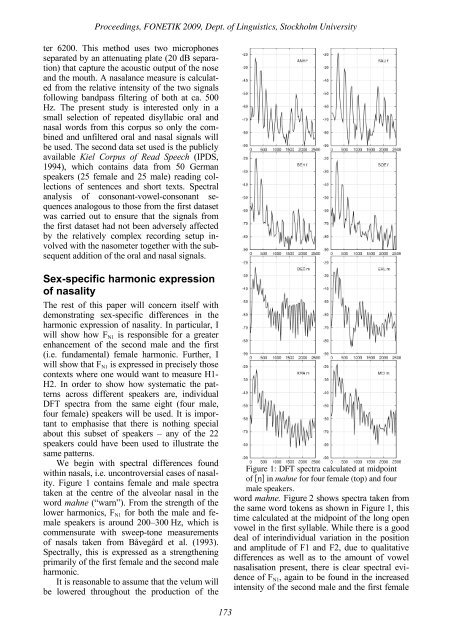Proceedings Fonetik 2009 - Institutionen för lingvistik
Proceedings Fonetik 2009 - Institutionen för lingvistik
Proceedings Fonetik 2009 - Institutionen för lingvistik
Create successful ePaper yourself
Turn your PDF publications into a flip-book with our unique Google optimized e-Paper software.
<strong>Proceedings</strong>, FONETIK <strong>2009</strong>, Dept. of Linguistics, Stockholm Universityter 6200. This method uses two microphonesseparated by an attenuating plate (20 dB separation)that capture the acoustic output of the noseand the mouth. A nasalance measure is calculatedfrom the relative intensity of the two signalsfollowing bandpass filtering of both at ca. 500Hz. The present study is interested only in asmall selection of repeated disyllabic oral andnasal words from this corpus so only the combinedand unfiltered oral and nasal signals willbe used. The second data set used is the publiclyavailable Kiel Corpus of Read Speech (IPDS,1994), which contains data from 50 Germanspeakers (25 female and 25 male) reading collectionsof sentences and short texts. Spectralanalysis of consonant-vowel-consonant sequencesanalogous to those from the first datasetwas carried out to ensure that the signals fromthe first dataset had not been adversely affectedby the relatively complex recording setup involvedwith the nasometer together with the subsequentaddition of the oral and nasal signals.Sex-specific harmonic expressionof nasalityThe rest of this paper will concern itself withdemonstrating sex-specific differences in theharmonic expression of nasality. In particular, Iwill show how F N1 is responsible for a greaterenhancement of the second male and the first(i.e. fundamental) female harmonic. Further, Iwill show that F N1 is expressed in precisely thosecontexts where one would want to measure H1-H2. In order to show how systematic the patternsacross different speakers are, individualDFT spectra from the same eight (four male,four female) speakers will be used. It is importantto emphasise that there is nothing specialabout this subset of speakers – any of the 22speakers could have been used to illustrate thesame patterns.We begin with spectral differences foundwithin nasals, i.e. uncontroversial cases of nasality.Figure 1 contains female and male spectrataken at the centre of the alveolar nasal in theword mahne (“warn”). From the strength of thelower harmonics, F N1 for both the male and femalespeakers is around 200–300 Hz, which iscommensurate with sweep-tone measurementsof nasals taken from Båvegård et al. (1993).Spectrally, this is expressed as a strengtheningprimarily of the first female and the second maleharmonic.It is reasonable to assume that the velum willbe lowered throughout the production of theFigure 1: DFT spectra calculated at midpointof [n] in mahne for four female (top) and fourmale speakers.word mahne. Figure 2 shows spectra taken fromthe same word tokens as shown in Figure 1, thistime calculated at the midpoint of the long openvowel in the first syllable. While there is a gooddeal of interindividual variation in the positionand amplitude of F1 and F2, due to qualitativedifferences as well as to the amount of vowelnasalisation present, there is clear spectral evidenceof F N1 , again to be found in the increasedintensity of the second male and the first female173
















